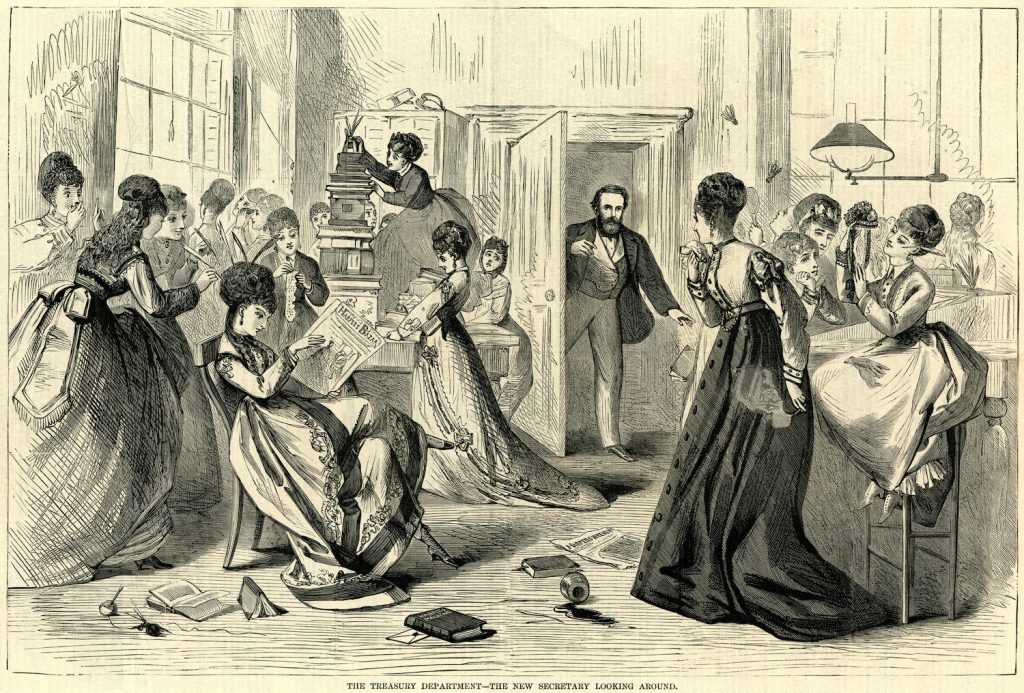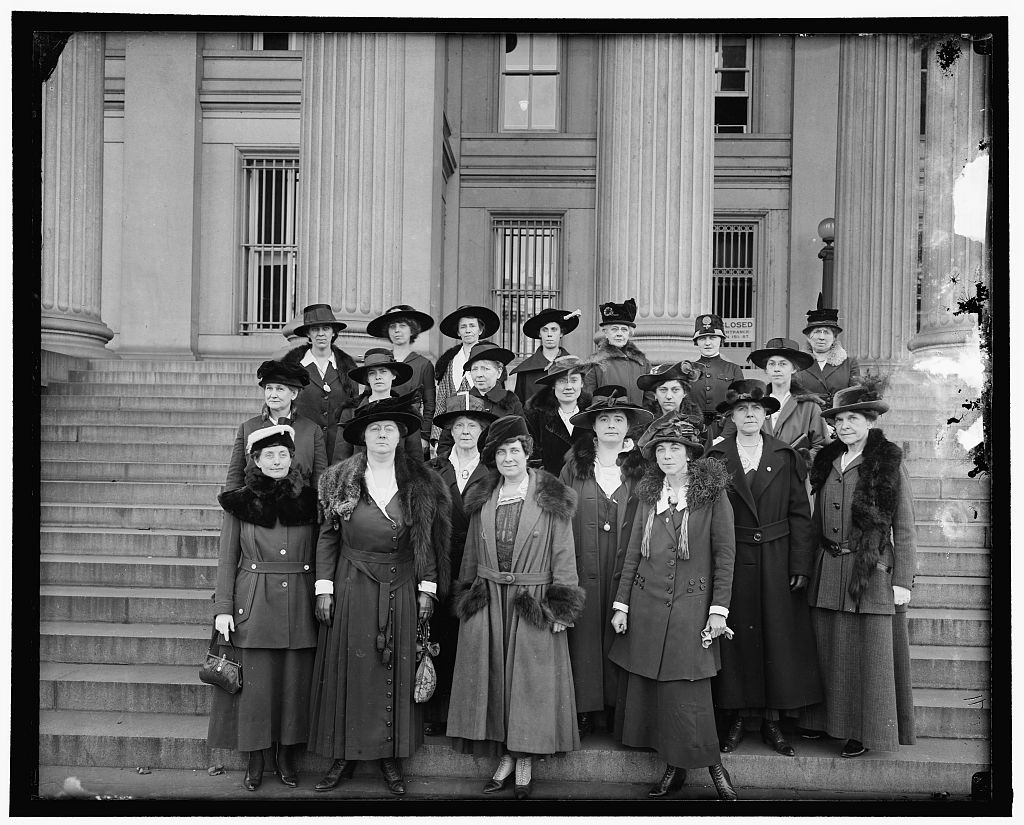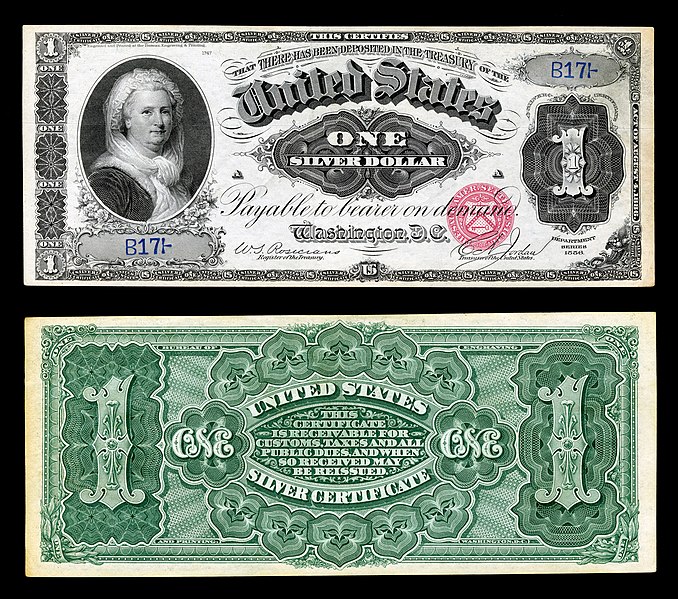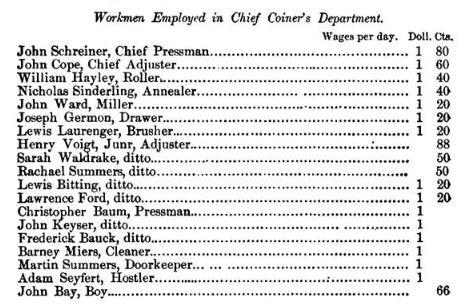This Inside FRASER guest post is drawn from a webinar presentation, “The Experiment of Employing Females as Clerks Has Been…a Success,” created by U.S. Department of the Treasury librarians Kim Carter and Andy Young. The webinar was presented before the Federal Depository Library Program (FDLP) Academy audience on February 8, 2022. A recording of the webinar, the slide presentation (including an appendix noting laws and other research materials), and an audio transcript are available from the FDLP Academy. Learn more about the history, collections, and organizational structure of the Treasury library by visiting their website.
The Treasury Girls
During the American Civil War, Francis Elias Spinner served from 1861-1865 as the 10th treasurer of the United States, under President Lincoln. Though Spinner is responsible for the first major effort to employ women in the federal government, his effort was out of necessity, not an enlightened sense of equality: Before Spinner’s tenure, women had been hired sporadically, but due to the Civil War, there was a shortage of men available for employment. The Legal Tender Act, passed by Congress in February 1862, authorized the use of paper notes to pay the government’s bills. These notes had to be cut manually with scissors,[1] and Spinner had the idea of hiring women to do this work, rationalizing that women were more experienced with scissors and that they would do the work for less pay. The women who worked for the Treasury became known as “Treasury girls.”

During the Civil War, about 400 women were employed by the Treasury, mostly as counterfeit inspectors and currency trimmers.[2] Women who wanted to work for the Treasury were subject to the prejudices of the day, and all were required to submit a letter of recommendation from a man. Most of the women the Treasury hired were white and middle-class. Although Spinner’s program was initially based on need and not a sense of egalitarianism, he spoke highly of the women he employed and lobbied for raises on their behalf. The War Department and Office of the Quartermaster General took notice of the success of the program and, in 1862, also began to hire women, though at a much lower salary than men. In the 1870s, Spinner was still hiring women for Treasury jobs, and took great pride in his role in bringing more women into the federal workplace, stating “The fact that I was instrumental in introducing women to employment in the offices of the Government gives me more real satisfaction than all the other deeds of my life.”[3]
The societal perception of women working for the Treasury varied over time. In the early days, there was some tolerance to see how increasing the numbers of women in the ranks of the Treasury would work out. Soon after, periodicals of the time evoked imagery of harems and referred to women in salacious terms. Women working in the government was seen by some as immoral and improper, and at one point, the Treasury was accused of being a house of prostitution. In 1864, this idea was popularized by an accusation of fraud within the Bureau of Engraving and Printing related to the introduction of greenbacks. These fraud claims prompted a congressional investigation into the possibility of various forms of immorality happening at the Treasury, which were proven false.

Despite efforts to maintain a negative public reception around women working for the Treasury, more government agencies began to hire women, and the moniker “Treasury girls” became “government girls.” In 1864, the annual appropriations act[4] stated that women could be employed in four clerical classes but could not earn more than $600, so their salaries were capped at that figure until the annual appropriations act of 1866[5] allowed for higher pay, but in such a way that made it difficult for women to advance in their careers. There were some women employees who stayed on for full careers within the federal government, but most spent only a few years or less as government workers. At the end of the Civil War, many women left voluntarily or were fired from government positions, as American bureaucracy was changing and moving into a peacetime economy.
The War Bond Story
In the throes of World War I, Secretary of the Treasury William G. McAdoo believed that no democratic appeal, specifically to buy war bonds, could be made without the help of women citizens. Though there was some concern that allowing women to work on behalf of the war effort could contribute to the successful ratification of the 19th Amendment, the National Woman’s Liberty Loan Committee was formed in May of 1917. McAdoo appointed its members “with the belief that the women of the Nation would constitute a powerful moral force in war finance.”[6] The purpose of the committee was to sell bonds and rally patriotism, and it was structured on national and local levels throughout the United States.

Throughout World War I, the committee raised awareness through war bond rallies organized across the nation and used famous faces from Hollywood and pop culture to advertise war bonds and the importance of buying them. The initial work of the first committee was largely about raising visibility of the war effort, but subsequent campaigns were dedicated to bringing in money. These campaigns raised millions of dollars and were considered a great success.[7]
Representation on Currency
In the late 1800s, a portrait of Martha Washington appeared on the face of the one-dollar silver certificate. With the exception of background images or periphery images, such as Pocahontas on an earlier issue $20 note, or allegorical figures such as Lady Liberty or Columbia, Washington became the only woman to appear on paper currency issued by the Bureau of Engraving and Printing. However, women have had slightly better representation on coins issued by the U.S. Mint.

Nearly 200 years after the first Mint was established in 1792, Congress authorized the Susan B. Anthony dollar with the Susan B. Anthony Coin Act of 1978. This dollar, a smaller version of the classic silver dollar, replaced the Eisenhower dollar and was the first time a woman appeared on a circulating coin. The coin remained in production until 1981 and returned in 1999. In 2000, the Susan B. Anthony coin was replaced by the Sacajawea dollar, also called the “golden dollar.” In 2003, as part of the 50 State Quarters Program, the Alabama state quarter featured Helen Keller.[8]
With the passage of the Native American $1 Coin Act, the reverse design on the dollar coin began to change annually to feature ethnically, racially, and geographically diverse individuals, such as Jim Thorpe, Elizabeth Peratrovich, and the Navajo code talkers. A four-year program authorized by the Circulating Collectible Coin Redesign Act of 2020 will include coins featuring women, such as Maya Angelou, with the Mint issuing new and diverse designs annually until 2025.[9]
Past and Present
Women have served in different capacities in the U.S. Treasury for over two centuries,[10] beginning with Sarah Waldrake and Rachel Summers, the first women hired by the Treasury in 1795.[11] Waldrake and Summers worked as adjusters in the Chief Coiner’s Department, weighing coins and filing them down if they were too heavy.[12] The women were each paid 50 cents per day for this work.

In 1861, Helen Bennett became the first woman hired to work in the Treasury building, working under her husband’s name until he died and then working under her brother’s name. One year later, in 1862, Jenny Douglas was hired by Secretary Spinner to trim bills, working under her own name in the Treasury Department. That same year, the Treasury hired Sophia Holmes, the first Black woman to be hired by the U.S. government. Helen MacLean Kimball was hired by the Treasury in 1865, and she would eventually become the first woman librarian at the Treasury.
The first woman to serve as director of the U.S. Mint was Nellie Tayloe Ross, appointed in 1933. Ross became one of the longest serving directors of the Mint, serving five full terms before retiring in 1953. In 1949, Georgia Neese Clark was appointed to the position of treasurer of the United States, the first woman to hold that position. Romana Acosta Bañuelos became the first Hispanic treasurer of the United States in 1971, and in 1977, Azie Taylor Morton became the only Black person to hold the position. In 2021, Janet Yellen became the first woman Secretary of the Treasury and one of the few to have a PhD. Yellen is also the first person in American history to have led the White House Council of Economic Advisers, the Federal Reserve, and the Treasury Department.

In 2010, the Dodd-Frank Wall Street Reform and Consumer Protection Act was signed into law by President Obama, establishing the Office of Minority and Women Inclusion (OMWI). OMWI consists of offices in eight financial agencies and all 12 Federal Reserve Banks and is responsible for developing standards for equal employment opportunities and for establishing procedures to determine if agency contractors and subcontractors have made efforts to include minorities and women in the workforce. OMWI reports to Congress annually, and the 2020 report showed that women made up 44% of the workforce is Treasury departmental offices, but it also showed that the higher the supervisory management or executive position, the less likely it is for a woman to hold that position.
Today, women workers are an integral part of the Treasury and all federal agencies. The first women workers, the “Treasury girls,” and the women leaders that followed helped forge the path to more and greater opportunities—and respect—for women. As Janet Yellen proved, achievement for women is no longer limited in the way it once was.
[1] For a detailed account of the work of women in the Treasury Department, see the following: Mary Clemmer. “Ten Years in Washington: Life and Scenes in the National Capital, as a Woman Sees Them.” 1873.
[2] Abby L. Gilbert. “Treasury Women, 1795-1975: From Sarah to Anita.” 1976.
[3] United States Congress. Senate. “Twelfth Report of the National Society of the Daughters of the American Revolution, October 11, 1908, to October 11, 1909.” 61st Congress, 1909. S. Doc 517, serial 104.
[4] United States. Congress. “Act of March 14, 1864.” U.S. Statutes at Large 13. 1864.
[5] United States. Congress. “Act of July 23, 1866.” U.S. Statutes at Large 14. 1866.
[6] National Woman’s Liberty Loan Committee. “Report of the National Woman’s Liberty Loan Committee for the Fourth Liberty Loan Campaign.” 1918.
[7] For a detailed overview of the Liberty Loan campaigns and their outcomes, see the following: Labert St. Clair. “The Story of the Liberty Loans.” 1919.
[8] United States Mint. “Alabama Official First Day Coin Cover.” March 24, 2003.
[9] United States Mint. “United States Mint Announces Designs for 2022 American Women QuartersTM Program Coins.” October 6, 2021.
[10] Read more about changes to women’s roles in the U.S. Treasury in the following U.S. Treasury publications: “Status of Women in the Treasury Department,” 1964; “Focus on Women ’75 at Bureau of the Public Debt.” Bureau of the Public Debt, 1975; “Treasury Women 3.0: The Secretary’s Initiative on the Status of Women.” December 2012.
[11] Gilbert (1976).
[12] George Greenlief Evans. “Illustrated History of the United States Mint.” 1887.
© 2022, Federal Reserve Bank of St. Louis. The views expressed are those of the author(s) and do not necessarily reflect official positions of the Federal Reserve Bank of St. Louis or the Federal Reserve System.


 @FedFRASER
@FedFRASER